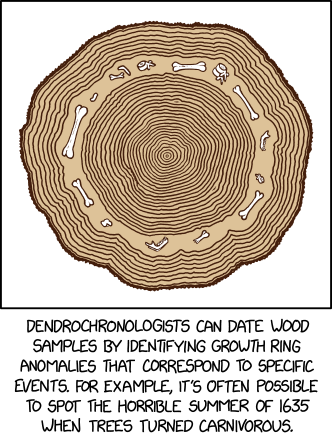#2847: Dendrochronology
Permalink
Transcript
[A round cross section of a tree in beige, with a brown bark around the outside and 33 narrow rings, along with one very wide ring that contains various white bones, including limb bones, vertebrae, and jaw bones. The wide ring appears after the 26th narrow ring.]
[Caption below the panel:]
Dendrochronologists can date wood samples by identifying growth ring anomalies that correspond to specific events. For example, it's often possible to spot the horrible summer of 1635 when trees turned carnivorous.
(Sourced from explainxkcd.com)
Title text:These anomalies are known as Miyake events, named for the pioneering scientist who discovered them and was tragically devoured by a carnivorous tree.